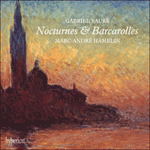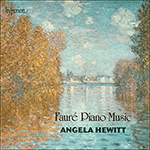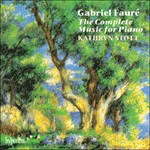
Welcome to Hyperion Records, a British classical label devoted to presenting high-quality recordings of music of all styles and from all periods from the twelfth century to the twenty-first.
Hyperion offers both CDs, and downloads in a number of formats. The site is also available in several languages.
Please use the dropdown buttons to set your preferred options, or use the checkbox to accept the defaults.

The D flat major sixth nocturne (1894) exhibits extended, irregular phrase lengths and chromatic manipulations which share that quality of freshness and adventure; and the central section, with its melody high above flurries of glittering semiquavers, is so beautiful that once a society lady begged to know where he had dreamed it up. Fauré replied: ‘In the Simplon Tunnel.’ Gradually the different ideas are brought together and implode. Then the opening idea returns, to reach a soft close.
In 1904 Emma finally left her husband … for Claude Debussy.
from notes by Jessica Duchen © 2023
Dans le sixième nocturne (1894), en ré bémol majeur, les phrases sont plus longues et irrégulières, avec des manipulations chromatiques qui partagent cette qualité de fraîcheur et d’aventure; et la section centrale, la mélodie scintillant au-dessus de rafales de doubles croches étincelantes, est si belle qu’un jour, une dame de la haute société lui demanda où il l’avait conçue. Fauré répondit: «Sous le tunnel du Simplon.» Peu à peu, les différentes idées sont réunies et implosent. Ensuite, l’idée initiale revient, pour atteindre une douce conclusion.
En 1904, Emma finit par quitter son mari … pour Claude Debussy.
extrait des notes rédigées par Jessica Duchen © 2023
Français: Marie-Stella Pâris
Einen ähnlichen Eindruck vermitteln erweiterte, unregelmäßige Phrasen und chromatische Wendungen im Nocturne Nr. 6 Des-Dur (1894); und der Mittelteil mit einer Melodie, die über Schwärmen flirrender Sechzehntelnoten aufleuchtet, ist von solcher Schönheit, dass eine Dame ihn einmal bat zu verraten, wo er diese Musik erträumt hätte. Fauré erwiderte: „Im Simplon-Tunnel.“ Schrittweise werden die Themen kombiniert und fallen in sich zusammen. Das Anfangsthema kehrt zurück und führt das Stück zu einem ruhigen Schluss.
1904 verließ Emma ihren Ehemann—um mit Claude Debussy zusammenzuleben.
aus dem Begleittext von Jessica Duchen © 2023
Deutsch: Friedrich Sprondel
 Fauré: Nocturnes & Barcarolles Fauré: Nocturnes & BarcarollesThe Nocturnes and Barcarolles demonstrate Fauré’s art at its most personal, progressing from early lyricism to the elusive, rarefied style of the later works. Marc-André Hamelin’s performances are predictably fine, and combine exceptional subtlety ...» More |
 Fauré: Piano Music Fauré: Piano Music‘The best performances of this music I have heard. Her interpretations combine freedom and control in performances that range from the most tender ly ... ‘Take, for instance, the Fourth Nocturne—in Stott's hands a suave miracle of purling pearliness, fraught with delicate hesitations and suppressed sigh ...» More |
 Fauré: Piano Music Fauré: Piano MusicAngela Hewitt’s recordings of French piano music have received the highest critical acclaim, her ‘tenderness, Gallic wit, verve, and—the most important ingredient of all—charm’ proving perfect for this repertoire. This album includes the major wor ...» More |
 Fauré: The Complete Music for Piano Fauré: The Complete Music for PianoThis welcome release presents Fauré’s complete music for piano, in benchmark performances by Kathryn Stott. 4 hours and 56 minutes of pure pleasure.» More |

